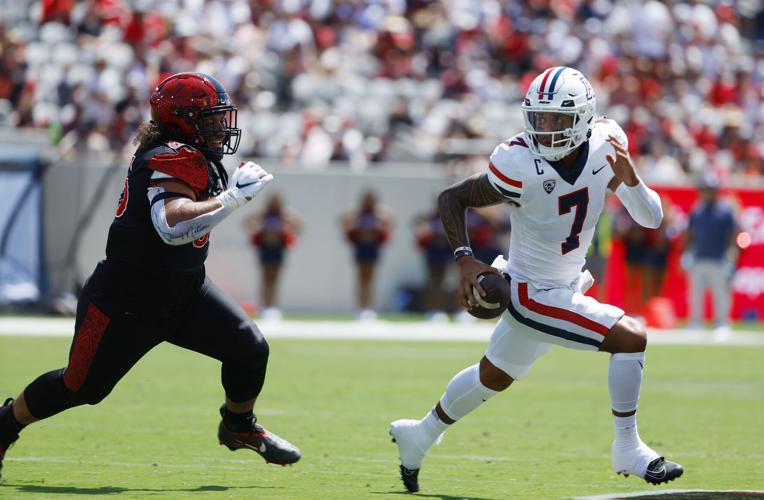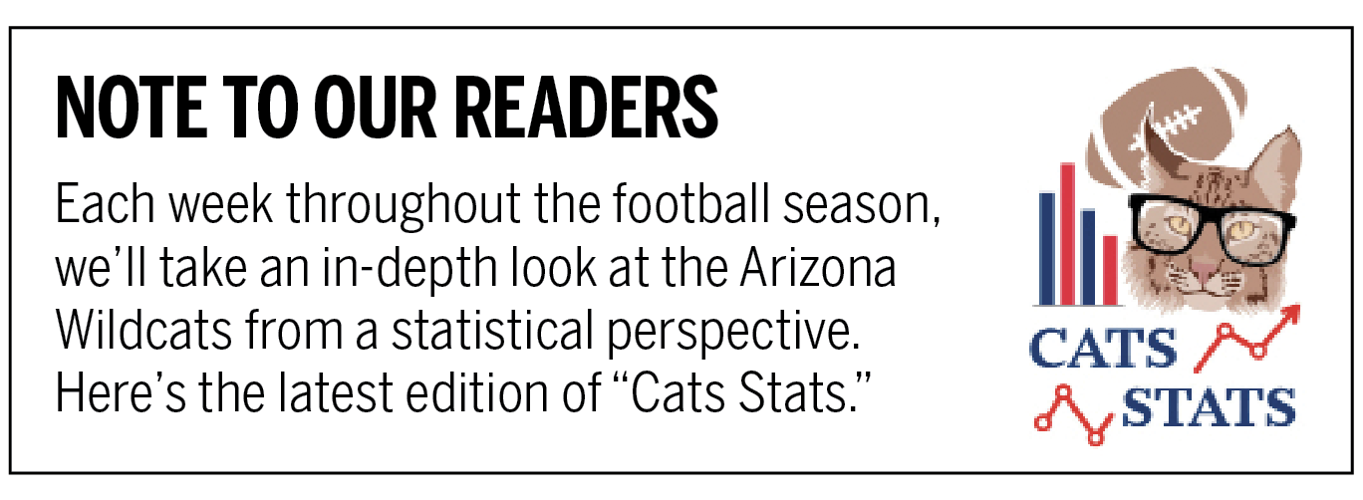When he took over as Arizona coach, Jedd Fisch had a lot of holes to patch. The ship was sinking. He couldn’t stop all the leaks in one year. It might take several.
Fisch knew he couldn’t solve every problem. So, when it came to on-field matters, he narrowed it down, focusing on two critical facets this past offseason: the red zone (both offense and defense) and takeaways.
The Wildcats improved immensely in those areas in their opener last week. The UA scored four touchdowns in five trips inside the 20-yard line while limiting San Diego State to one in four. Arizona also took the ball away two times.
Red-zone offense, red-zone defense and takeaways were three of 10 areas in need of improvement that we spotlighted in the season debut of Cats Stats.

Like we said, lots of issues.
All the way at the bottom, at No. 10, was third-down percentage. It’s been a bugaboo for Arizona for years, on both sides of the ball.
It turned out to be a critical factor in the Wildcats’ 38-20 win over the Aztecs.
Arizona converted 6 of 13 third downs, or 46.2%. SDSU converted 2 of 11, or 18.2%.
Only twice last season did the Wildcats have a higher third-down percentage than their opponent. One instance came in Arizona’s lone victory over Cal – 52.6% for the Wildcats, 7.1% for the Golden Bears. The other came the previous week against USC — 53.3% vs. 46.2%. Arizona had a season-high 34 points in that game.
The Wildcats lost the third-down battle every other week — which was nothing new. Arizona has had a lower third-down percentage than the opposition in seven of the past eight seasons. The lone exception: 2018 (when the Wildcats should have gone bowling at 6-6 ... until the fourth quarter of the Territorial Cup happened).
Arizona’s worst third-down performance last season came against SDSU. The Wildcats were just 1 of 14 (7.1%).
Arizona couldn’t convert on third-and-3 or third-and-2 (twice) in last year’s matchup. Most of its third downs required a much longer journey. The Wildcats needed 10 or more yards on nine of their 14 third downs in that game. The average distance to gain a first down was 10.7 yards.
Fast-forward a year. By performing better on first and second downs, Arizona nearly halved that figure. The average distance to gain a first down last week was 5.6 yards.
The Wildcats faced four third-and-short situations (1-3 yards), five third-and-mediums (4-6 yards) and four third-and-longs (7 or more yards). Typically, the more yards that are needed, the harder it is to convert. Arizona’s success rates aligned perfectly with that thesis: 75% on third-and-short, 40% on third-and-medium, 25% on third-and-long.
The Wildcats’ lone failure on third-and-short came on the opening possession, when DJ Williams initially was ruled to have gained a first down on third-and-1 before replay reversed the call (a questionable ruling at best). Just as he did in last year’s opener, Fisch decided to go for it on fourth-and-1 from inside the UA 40 in the first quarter. Jonah Coleman rushed for 3 yards, and Arizona was on its way.
On the other side of the ball, SDSU faced an average distance of 6.3 yards on its 11 third downs. The Aztecs were 1 of 2 (50%) on third-and-short, 1 of 4 (25%) on third-and-medium and 0 of 5 (0.0%) on third-and-long. SDSU isn’t built to convert on third-and-long. The Wildcats succeeded, big time, in getting the Aztecs out of their comfort zone.
Third downs will play a massive role in this week’s matchup against Mississippi State. Memphis couldn’t get MSU’s offense off the field, and it was a decisive factor in the Bulldogs’ 49-23 victory.
MSU went 11 of 13 on third downs against Memphis. The Bulldogs’ 84.6% conversion rate ranks third in FBS entering Week 2.
MSU set itself up for success. The Bulldogs’ average distance on third downs was 4.2 yards. Eight were of the third-and-short variety. Five required only 1 yard.
With Memphis converting only 3 of 12 third downs, time of possession and total plays swung heavily in Mississippi State’s favor. The Bulldogs held the ball for 41 minutes, 11 seconds — their highest total under Mike Leach and the second-highest figure in the nation last week. (Minnesota possessed the ball for 44:24 in a 38-0 victory over New Mexico State. The Golden Gophers were 11 of 14 on third down.)
MSU ran 83 plays to Memphis’ 51. The Bulldogs had 34 first downs, the Tigers 13. It was death by a thousand paper cuts.
(MSU did have six passing plays of 20-plus yards. SDSU’s longest gain against Arizona was 19 yards. The last time Arizona held an opponent without a single scrimmage play of at least 20 yards was Sept. 15, 2012, vs. South Carolina State.)
Arizona ran 15 more plays than San Diego State and had 11 more first downs. Time of possession wasn’t quite as one-sided (32:37-27:33). But Wildcats defensive coordinator Johnny Nansen said the UA offense, in particular the run game, helped his group by keeping it off the field on a 100-degree afternoon.
The heat shouldn’t be an issue with an 8 p.m. kickoff Saturday. But the Wildcats can’t allow quarterback Will Rogers — a 72.5% career passer — to methodically pick them apart.
Getting Rogers and the Mississippi State offense off the field on third down will be essential. So will extending drives by converting third downs.
Arizona is off to a promising start on both fronts.






